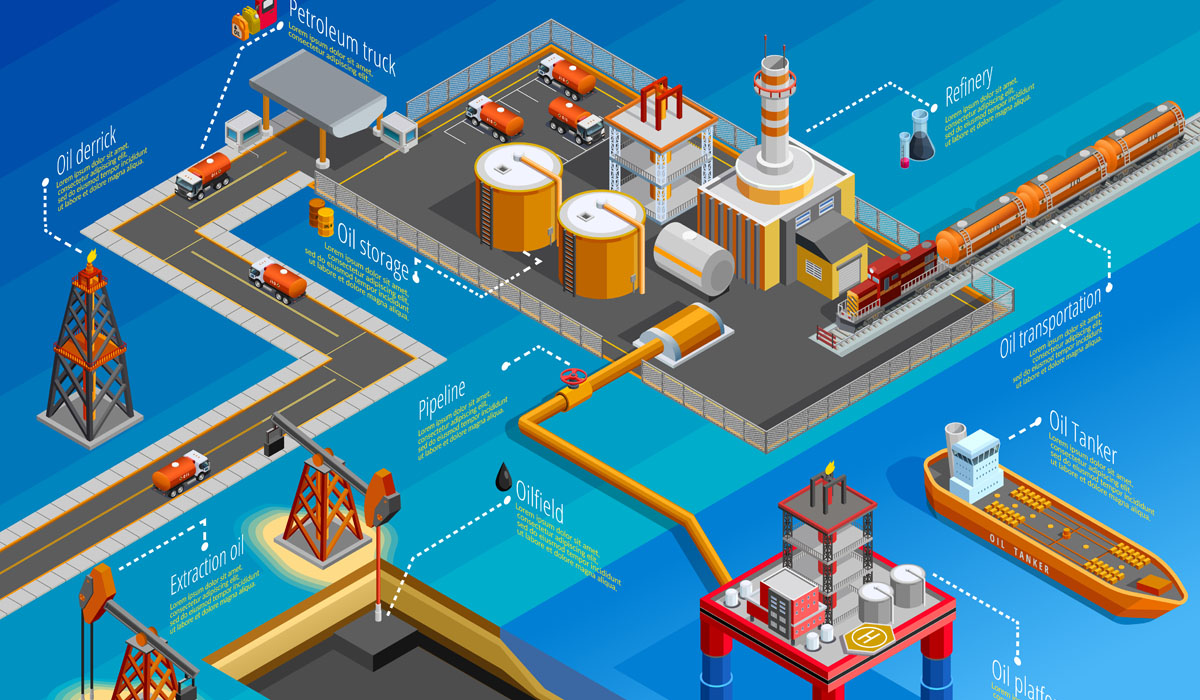Excellent Ai Solutions In The Oil And Gas Industry
Artificial intelligence is proven to be a significant enabler for oil & gas projects with various applications. These include production optimization with computer vision to evaluate seismic and subsurface data more quickly, minimising equipment downtime for predictive maintenance, comprehending reservoirs, and modelling for forecasting oil corrosion hazards to decrease maintenance costs.
Here are a few other significant use cases and application areas:
1. Surface Analysis/Geological Evaluation
AI is truly proving to be a treasure for O&G exploration leaders. For instance, ExxonMobil intends to deploy the deep-sea AI robot to improve its ability to locate natural seeps. ExxonMobil's AI-enabled robots can detect these oil leaks, which will eventually minimise exploration risk and marine life damage. The Wadia Institute of Himalayan Geology (WIHG) found a novel AI-based technology in September 2020 that aids in interpreting data from seismic waves (natural or created by explosive material) to assess the geological characteristics under the surface, hence facilitating the discovery of hydrocarbons such as oil and natural gas in less time and with more efficiency. Briefly, AI systems are being used to analyse subsurface geophysical data and map subterranean oil resources precisely. This approach finally provides the precise value of the reservoir and increases the efficiency of drilling operations.
2. Reduce Well and Equipment Downtime
Unplanned downtimes cost offshore oil and gas installations millions of dollars each day in the case of catastrophic asset breakdowns!
According to a whitepaper by the World Economic Forum titled 'Digital Transformation Initiative' by Oil and Gas Industry, 92% of refinery shutdowns were due to unscheduled maintenance, costing oil and gas businesses between $42 million and $88 million annually.
This is where Artificial Intelligence, Data Science, and IoT-based predictive analysis aid in generating significant cost reductions.
Using AI, one of the largest O&G corporations improved its capacity to detect well collapses before they occur, decrease maintenance, operate the wells effectively, and extend their remaining useful life. What was their strategy? The engineers of the factory created a traffic signal system that alerted them to the imminent risk of a well collapse. This allowed them to operationalize and implement the strategy for reducing downtime. The deployment of AI-powered assistants enabled the facility to lower the time required to revive a well by up to 83% and the cost of alternative fuel per well per day by $20,000 per well.
3. Optimizing Scheduling and Production
Cost and time overruns are pervasive issues for offshore oil projects, according to data conducted by One-Petro. This is attributable in part to weather delays, resource constraints, and scheduling hazards. During the normal build-up phase of oilfield development, a vast number of interdependent operations, including as drilling and platform installation, contribute to the problem's complexity. Offshore oil projects require comprehensive project planning and scheduling models that account for these interdependent components and related hazards.
According to a JPT article, an AI-based application enables operators to anticipate breakdowns of electrical submersible pumps (ESPs) while maximising production. Offshore operators having access to cloud-based platforms have access to advanced analytics software containing AI algorithms that evaluate incoming data for abnormalities, eventually signalling impending equipment failure.
4. Asset Monitoring and Upkeep/Digital Twins
Asset management, including its monitoring and maintenance, project planning, and lifecycle management, is one of the most significant areas in which digital twin (DT) technology may play a vital role.
According to ARC Web analysts, around 63% of oil field assets have beyond the midpoint of their estimated lifespan, making it more difficult to determine the actual health of equipment.
Digital Twins help oil and gas businesses to overcome production imbalances, sudden changes in global economic conditions such as the COVID-19 pandemic, and equipment dependability difficulties in such a scenario.
To be responsive in these hectic and chaotic times, oil and gas firms want systems with real-time visibility and flexibility, which digital twins give.

5. Detection of Defects
Detecting improper threading in pipes or flaws in fault-prone systems is one of the difficulties faced by the oil and gas industry. Defects discovered at the end of the manufacturing line due to upstream difficulties result in significant factory and budgetary losses.
To this purpose, AI may assist in validating production quality and providing in-depth insights regarding analytical flaws. AI-powered Defect Detection systems are incredibly affordable and cost-effective compared to traditional methods.
Using pattern recognition and deep learning, video feeds captured by cameras can trigger an alarm if an employee is not appropriately attired for the set of tasks. Moreover, predictive analytics alert the operators to the health status of the equipment, allowing initiative-taking measures to be taken to avert a disaster with adverse effects on health, safety, and the environment.
6. AI-driven Cybersecurity
Siemens said in a Ponemon Institute poll that 70 percent of oil and gas companies have experienced security breaches. According to the PwC Global State of Information Security Survey, 42% of energy companies acknowledged to being victims of phishing attempts.
The increase in physical and cyberattacks, as well as its security costs, has prompted the use of artificial intelligence solutions to encrypt the enterprise's operating system. Video cameras as sensors aid in the continuous monitoring of security concerns in utilities. When integrated with software, utilities are protected across all endpoints.
7. Occupational safety
As a result of the use of heavy machinery, non-enclosed rotating equipment, high pressure, high-temperature activities, and aggressive chemicals, oilfield operations pose dangers to employees. A Science Direct report titled 'Artificial intelligence in oil and gas sector upstream: Trends, problems, and future scenarios' notes that IT systems based on deep learning assist safety officials in finding violations of safety rules.
8. Data-Driven Determination Making
'DATA is the new OIL' is a popular expression these days, and it is a fantastic metaphor for the oil and gas industry. The oil and gas industry manages a large amount of data resulting from industrial activities. However, due to a lack of proper analytics tools, businesses are unable to benefit on the vast amounts of data stored in data silos. AI systems analyse multiple data streams from various sensors and machinery of different plants or full Geoscience data to develop reasonable business ideas based on real-time analytics.
9. Emission Monitoring
According to research by McKinsey, several oil and gas corporations have already set up net-zero emissions goals. Despite economic difficulties, several businesses are trying to decarbonize their operations and value chains. Occidental Petroleum, an American oil and gas firm, has collaborated with Carbon Engineering, a Canadian start-up, to assure that the facility they construct would absorb and bury 500,000 metric tonnes of carbon dioxide per year.
According to BCG estimates, the potential global effect of applying AI to business sustainability by 2030 is between $1.3 trillion and $2.6 trillion in increased revenues and cost savings.
In order to better regulate fugitive emissions of greenhouse gases from pipelines and oilfield equipment, oil firms are adopting AI technologies to monitor these emissions. Additionally, upstream oil firms use AI to optimise CO2 storage for increased oil recovery.
10. Optimizations of Logistics Networks and Logistics
The oil and gas industry's supply chain are a complicated process that includes decision nodes such as crude acquisition, purchase price, transportation to the refinery, refining activities, gantry operations, and retail sale of final goods. In the upstream industry, AI assists in coordinating the operations team with the warehouse to assure the availability of essential components.
AI may enable appropriate planning and execution, optimal route selection, etc. in midstream industry. In contrast, it aids downstream businesses in planning proper blending, anticipating demand, calculating pricing, and enhancing customer relationships. Briefly, AI assists oil & gas companies with the prediction of the market price of crude oil and finished products, proper planning and scheduling, the optimization of the crude basket, the creation of a smart warehouse, the maintenance of inventories, the management of shipping operations, risk hedging, and the improvement of delivery times and the reduction of overall costs.

11. AI-Driven Inventory Administration
When supply falls behind demand, businesses incur losses. AI increases network planning and demand forecasting efficiency, allowing merchandisers to become more proactive. As oil and gas businesses get greater insight into demand patterns, they will be able to plan for a seamless supply by altering the number of trucks and directing them to places with the highest expected demand. Consequently, operating expenses are reduced.
12. Backoffice Process Optimization
According to the research Global Artificial Intelligence (AI) in the Oil and Gas Market Ecosystem, Artificial Intelligence (AI) in the Oil & Gas Market sector is transforming operations by developing future "digital oilfields."
According to the study, Shell has deployed Smart Fields to raise the total quantity of oil recovered from a field by 10 percent and boost production rates.
The AI technology enables sensors with fibre optic cables to transmit digital information about temperature, pressure, and other field conditions to control centres, where engineers continuously monitor production and make prompt decisions regarding the optimal method/process for oil & gas extraction. In addition, these technologies provide the electronic activation of subsurface valves for improved oil flow control.
13. Optimized procurement
AI-driven specialist procurement solutions may aid O&G companies in constructing linked digital supply networks (DSNs), so enabling their planning and execution to be dynamic, flexible, and efficient. AI may complement the decision-making abilities of procurement specialists by providing new insights from the processing and analysis of exceedingly complicated and big data sets to address conventional challenges.
Using an AI-based solution can alleviate some of the current challenges in oil and gas (O&G) procurement by assisting companies in comprehending major procurement spend categories, automating purchase-to-pay, identifying critical and noncritical supply chain bottlenecks, and gaining visibility into planned and actual figures by supplier, material, geography, and other company-specific dimensions.


